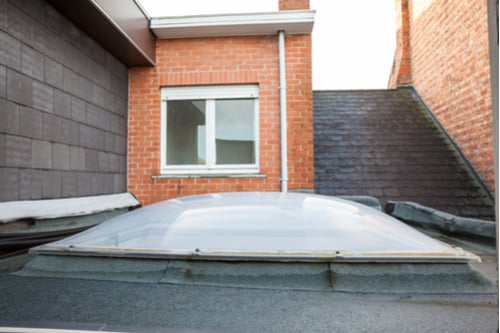Flat roofs get a bad press, but remain popular, especially for modern blocks, outhouses, garages and extensions as they can be relatively inexpensive, and, with their low profile, they don’t obstruct views from other parts of the building.
The problems come when they are too flat and not properly maintained.
They are, by definition, non-standard risks for insurers, so we need to ask about them – and you need to tell us if you have felt roofing at the premises. A good broker will then help insurers to assess the risk your roof presents.
Factors affecting your risk level will include the structure, maintenance regime, repairs and claims history. We will use all the information we can to negotiate the best premium for your specific circumstances. That’s why we like to talk to our customers in person.
To be clear, a flat roof that you need to tell us about is anything with a pitch of 15o (I in 6) or less: we’d expect most brokers to have similar criteria
Yes, you read it correctly: a flat roof shouldn’t really be flat at all! In fact, being too flat is often the root cause of problems. A completely flat roof may allow water ponding, no matter how clear the guttering is kept. That in turn can lead to a build-up of silt deposits on the roof and stresses in the membrane when the water freezes and thaws.
So, a flat roof should have a small incline of at least at least 1 in 80, preferably more, to allow for rainwater run-off. And it should have a decking of marine or WBP (water and boil proof) plywood.
Coverings include traditional torch-on felt, made from bitumen and generally used in combination with fibreglass underlay, and newer EDPM (Ethylene Propylene Diene Monomer) a synthetic rubber. Different roofers have their preferences but, at the end of the day, if your roof is too flat or decked with chipboard, then it doesn’t matter what you cover it with — it will eventually sag and leak again. The same can be expected of sticking plaster patch repairs.
Flat roofs and maintenance
Getting the pitch and drainage right and ensuring the roof in good repair is only the beginning of course. Twigs, leaves and all manner of debris is likely to fall and get caught in the gutters and drains and regular inspection and clearing is essential.
Repairs and insulation
The National Federation of Roofing Contractors warns that Building Regulations dictate that any flat roof being re-covered must simultaneously be insulated to the current standard. This means you must either notify your local authority’s building-control department to inspect and approve the work or employ a roofing contractor registered with one of the government’s “self-certification” schemes. Insulating a flat roof is clearly a good idea but must be done with care so as not to cause problems with condensation and wood rot in the structure. The NFRC also produces a useful homeowners guide to flat roofing.
FP314
Reviewed 15 August 2022
The sole purpose of this article is to provide guidance on the issues covered. This article is not intended to give legal advice, and, accordingly, it should not be relied upon. It should not be regarded as a comprehensive statement of the law and/or market practice in this area. We make no claims as to the completeness or accuracy of the information contained herein or in the links which were live at the date of publication. You should not act upon (or should refrain from acting upon) information in this publication without first seeking specific legal and/or specialist advice. Arthur J. Gallagher Insurance Brokers Limited trading as Deacon accepts no liability for any inaccuracy, omission or mistake in this publication, nor will we be responsible for any loss which may be suffered as a result of any person relying on the information contained herein.
